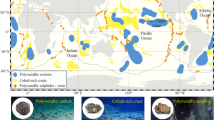Abstract
In this study, tidal stream energy resources of the Southwestern Sea of Korea were assessed using a numerical model, Modelo Hidrodinâmico (MOHID). This numerical model is based on the finite volume method, which allows numerical experiments on estuaries, coasts, and oceans. For the numerical experiment, we used grid data of at least 90 m resolution by applying bathymetry data created by the Korea Institute of Ocean Science & Technology (KIOST) and FES2012 data as a tidal boundary condition. Strong tidal currents occur in the Southwestern Sea of Korea due to the characteristics of the tidal systems of the West Sea and the South Sea, and the topographical characteristics of a Ria coast. These characteristics were appropriately reproduced by the numerical experiment. Accordingly, the average and maximum tidal currents calculated by the numerical model were used in the assessment. Two regions, Jangjuk and Maenggol-Geocha, were selected as the candidate areas for tidal stream energy development. In addition, the amounts of tidal stream energy resources were evaluated using geographical information system-based spatial analysis by applying the tidal current, depth data, and area of each region. The resource amounts were estimated to be 4,841 MW, with 5,743 tidal stream energy converters (TECs) for Jangjuk, and 3,497 MW, with 3,676 TECs for Maenggol-Geocha.
Similar content being viewed by others
References
Adcock TAA, Draper S, Houlsby GT, Borthwick AGL, Serhadlioğlu S (2013) The available power from tidal stream turbines in the Pentland Firth. P Roy Soc A-Math Phy 469(2157):1–21
Braunschweig F, Leitao PC, Fernandes L, Pina P, Neves JJ (2004) The object-oriented design of the integrated water modelling system MOHID. Dev Water Sci 55:1079–1090
BC Hydro (2002) Green energy study for British Columbia. Phase 2: Mainland. Engineering BC Hydro, Report No. E44, 36 p
Carrère L, Lyard F, Cancet M, Roblou L, Guillot A (2012) FES 2012: A new tidal model taking advantage of nearly 20 years of altimetry measurements. https://www.aviso.altimetry.fr/fileadmin/documents/OSTST/2012/oral/01_thursday_27/03_tides/04_TID_Carrere2.pdf. Accessed 5 Oct 2018
Douglas CA, Harrison GP, Chick JP (2008) Life cycle assessment of the Seagen marine current turbine. P I Mech Eng M-J Eng 222(1):1–12
ETSU (1993) Tidal stream energy review. Harwell Laboratory, Energy Technology Support Unit, Technical report ETSU-T-05/00155/REP, 100 p
EC (1996) The exploitation of tidal and marine currents, Non-nuclear energy-JOULE II, wave energy project results. Commission of the European Communities, Technical report EUR 16683 EN, 68 p
Garrett C, Cummins P (2007) The efficiency of a turbine in a tidal channel. J Fluid Mech 588:243–251
Garrett C, Cummins P (2013) Maximum power from a turbine farm in shallow water. J Fluid Mech 714:634–643
Huckerby J, Jeffrey H, de Andres A, Finlay L (2017) An international vision for ocean energy. Version III. Ocean Energy Systems Technology Collaboration Programme. https://www.oceanenergy-systems.org/ Accessed 8 May 2018
Jo C-H, Lee K-H, Cho B-K, Hwang S-J (2016) Resource assessment of tidal current energy using API in Korea. J Korean Solar Energ Soc 36(1):75–81
Kim H-S, Lee S-R, Yum G-D, Song W-O (1986) A numerical experiment of tidal current in the narrow channels with abrupt sectional changes. Ocean Res 8:57–62
Knoema (2017) Discover the world’s data. https://knoema.com. Accessed 15 Oct 2018
Ko D-H, Park J-S, Cho H-Y, Park J-S, Lee G-S, Choi H-J (2017) Distribution characteristics on the parameters of vertical tidal current profile at Uldolmok, Jindo, Korea. J Korean Soc Coast Ocean Eng 29(6):279–285 (in Korean)
Ko D-H, Park J-S, Lee K-S (2018) Assessment of tidal current energy potential at Uldolmok in the Southwestern Coast of Korea. J Coastal Res 85:1301–1305
KHOA (2010) A study on development of tidal current energy resources (I): based on observation velocity. Korea Hydrographic and Oceanographic Administration, Korean Ministry of Land, Transport and Maritime Affairs, 591 p (in Korean)
Legrand C (2009) Assessment of tidal stream energy resource: marine renewable energy guides. The European Marine Energy Centre Ltd, London, 50 p
NEAC (2017) Correspondence of the fourth industrial revolution and new climate regime. Korean National Economic Advisory Council (NEAC), Seoul, 166 p (in Korean)
Pawlowicz R, Beardsley B, Lentz S (2002) Classical tidal harmonic analysis including error estimates in MATLAB using T_TIDE. Comput Geosci 28(8):929–937
Rule BM, Worth ZJ, Boyle CA (2009) Comparison of life cycle carbon dioxide emissions and embodied energy in four renewable electricity generation technologies in New Zealand. Environ Sci Technol 43(16):6406-6413
Seo S-N (2008) Digital 30 sec gridded bathymetric data of Korea Marginal Seas — KorBathy30s. J Korean Soc Coast Ocean Eng 20(1):110–120 (in Korean)
Serhadlıoğlu S, Adcock TAA, Houlsby GT, Draper S, Borthwick AGL (2013) Tidal stream energy resource assessment of the Anglesey Skerries. Int J Mar Energy 3–4:e98–e111. doi:https://doi.org/10.1016/j.ijome.2013.11.014
Work PA, Haas KA, Defne Z, Gay T (2013) Tidal stream energy site assessment via three-dimensional model and measurements. Appl Energ 102:510–519
WEC (2016) World energy resources 2016. World Energy Council, London, 1027 p
Yoo H-R (2010) Characteristics of tide and tidal current in the Southwestern sea of Korea. M.D. Thesis, Inha University, 107 p (in Korean)
Acknowledgements
This study was a part of the project titled “Development of tidal current power generation-ESS hybrid system for the off-grid islands (Project No. 20190187)” funded by the Ministry of Oceans and Fisheries (MOF), Republic of Korea.
Author information
Authors and Affiliations
Corresponding author
Additional information
Publisher’s Note Springer Nature remains neutral with regard to jurisdictional claims in published maps and institutional affiliations.
Rights and permissions
About this article
Cite this article
Park, JS., Lee, CY., Park, JS. et al. Assessment of Tidal Stream Energy Resources Using a Numerical Model in Southwestern Sea of Korea. Ocean Sci. J. 54, 529–541 (2019). https://doi.org/10.1007/s12601-019-0038-2
Received:
Revised:
Accepted:
Published:
Issue Date:
DOI: https://doi.org/10.1007/s12601-019-0038-2




